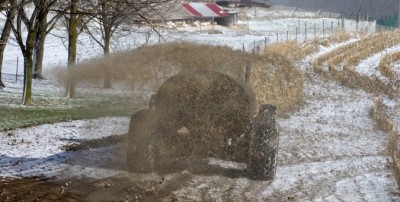Winter Manure Spreading Restrictions

Excerpt from "Winter manure restrictions in effect" in American Agriculturist by C. Torres & J. Kiel
In New York, there is no winter ban, but the following rules apply:
- Winter manure spreading must be in accordance with the Cornell University Nutrient Guidelines, NY P Index, NY NLI and RUSLE2.
It must be based on a check of the 48-hour weather forecast to assess if rainfall or temperatures are predicted to cause snowmelt or runoff conditions.
Manure must not be applied to soils designated by the soil survey as "frequently flooded."
Winter manure spreading must be in accordance with Section 1 in "Manure and Groundwater: The Case for Protective Measures and Supporting Guidelines" for fields with soils less than 40 inches deep over carbonate bedrock.
Manure can't be spread within a 100-foot flow path distance from surface waters, surface inlets, springs or sinkholes.
Manure can't be spread within 100 feet of wells.
Manure can't be applied in concentrated flow areas, such as well-defined channels within fields.
Cornell Universities revised winter and wet weather manure spreading guidelines to reduce water contamination risk, which can be found by clicking here https://bit.ly/3nVUttL, summarizes what factors to consider to avoid water contamination during winter and wet weather conditions.
Producers should work with their AEM Certified Planner to find ways to avoid having to spread during high risk and emergency situations. Even if the NY P Index or Nitrate Leaching Index allow for spreading on particular fields during a certain time of year, the decision to apply or not on any given day needs to be based on actual field and weather conditions. Sufficient manure storage and a well-designed and executed winter spreading plan can go a long way toward reducing losses. Actual manure application decisions should consider:
1. Near-term weather: Rain or snowmelt in the forecast?
2. Actual field conditions: Extent of snowpack, ice layer, frozen soil, or soil saturation.
3. Use of lower risk fields, identified in advance: On farms where some application is planned during winter months, work with your AEM Certified Planner to identify a significant acreage of lower risk fields for those applications (e.g., no history of runoff or groundwater issues, limited surface connection to streams/ditches, mild slopes, no concentrated flows, no karst or shallow soil features, high crop residue or surface roughness, etc.). Also with your Certified Planner, identify a smaller set of fields to save for emergency application fields or pile areas where manure can be taken in case of unexpected extreme conditions. Fields should have no history of runoff problems, be less than 5% slopes; as far as practical from any stream, ditch, well, or karst feature - preferably at least 300 feet; be accessible for equipment; have minimal runoff from upslope areas; and not be prone to frequent or occasional flooding (see NRCS 590 Standard for temporary manure pile siting).
4. Beneficial application management to further reduce runoff risk: Injection or incorporation, reducing application rates, introducing or increasing setback distance, applying to lower risk fields, applying to fields with ground cover such as hayfields, applying manure over a period of several days as opposed to all in one day, etc.
5. Access to manure storage: Including working with your Planner to develop more storage capacity if finding that applications during higher risk conditions are becoming commonplace. Also, consider asking a neighbor if they have storage room to spare.
Accurately predicting weather is difficult. The guidelines in this document cannot prevent all runoff, but increasing awareness of the conditions that contribute to runoff and development and implementation of winter spreading plans based on these guidelines should reduce the risk of significant runoff and water quality violations. It is most important that farm managers take steps to observe fields after applications to learn from what happens and to adjust practices accordingly. Further, producers and planners should carefully evaluate existing storage capacity to ensure adequate storage to avoid application during high risk conditions year in and year out, and consider that wet field conditions may need to be evaluated differently from concrete frost, ice or snow pack.
Upcoming Events
WNY Pastureland Conversion & Soil Health Field Day
July 16, 2025
Middleport, NY
Join American Farmland Trust for the Western New York Soil Health Field Day on July 16, 2025, at Zeliff Farm in Middleport, NY, from 9:00 AM-3:15 PM. Learn about pasture conversion, soil health benchmarking, biochar in grazing systems, and best grazing practices. Plus, enjoy hands-on demos with the NY Soil Health Trailer, drones, and cover crops! Check out the attached agenda for more information about the field day and REGISTER HERE. Zeliff Farms is a regenerative beef operation who has recently partnered with AFT on outreach and education to farmers including learning circles and evaluating biochar effects on soil health.
IPM Strategies to Protect Corn and Soybean Seed in NY
July 30, 2025
Hamburg , NY
SWNYDLFC and Cornell IPM are hosting a grower meeting to discuss integrated pest management strategies for protecting corn and soybean seed in New York.
FAMACHA Training for Sheep and Goat producers in Woodhull NY
August 13, 2025 : FAMACHA Training in Woodhull
Woodhull, NY
Join us for a discussion and hands-on training for internal parasite integrated pest management in sheep and goats. Certification is available to all students participating in the workshop.
Announcements
No announcements at this time.





